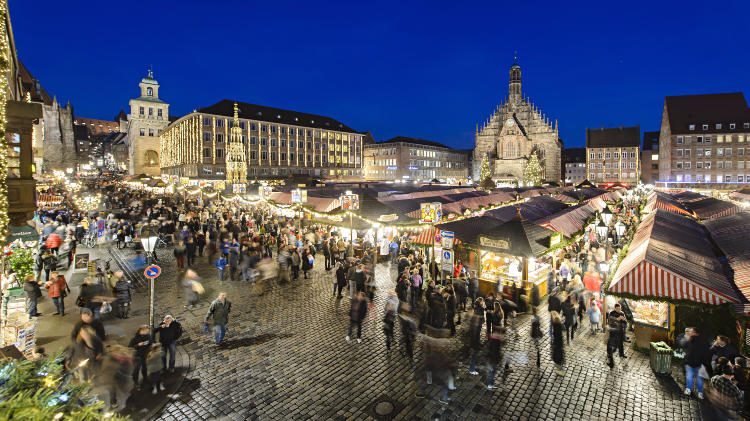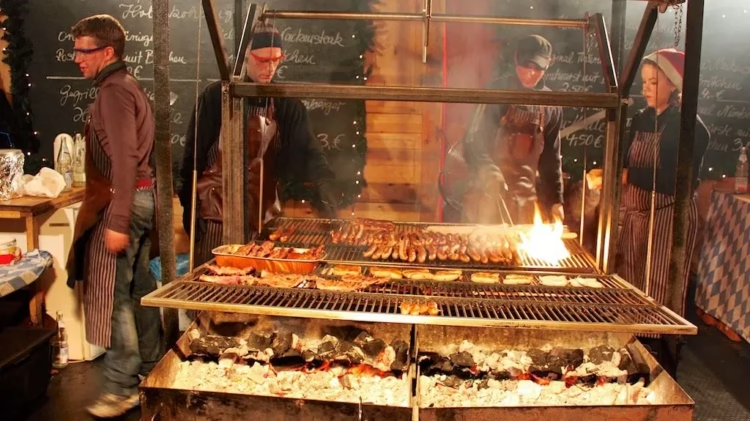Christmas markets (Weihnachtsmärkte), Glühwein, sausages, Lebkuchen biscuits, potato cakes, sweets, wooden toys, and music are the highlights of Advent in Germany.
In 2024, many German Christmas markets open on November 25 although the first Sunday of Advent is only December 1.
German Christmas markets (Weihnachtsmärkte) are outdoor winter markets held in the Advent period leading up to the Christmas holidays. The exact composition of the Weihnachtsmarkt varies between markets and regions. However, all Christmas markets have stalls selling food and Christmas-related wares. Popular food at German Christmas markets includes Glühwein (warm, spiced wine), Kinderpunch (spiced fruit juice), Lebkuchen gingerbread cakes, sausages, potato cakes, and baked items. Traditional Christmas tree decorations, candles, wooden toys, and sweets are preferred to cheap plastic imports and clothing. Many markets have live Christmas music and simple carousel rides.
The names of German Christmas markets vary from region to region. Weihnachtsmarkt (plural Weihnachtsmärkte) means Holy Night Market and is the basic word for Christmas market in standard High German and is understood everywhere. Regional variations are common — for example, in Dresden it is the Striezelmarkt, in Rothenburg the Reiterlesmarkt, while in most of Bavaria (and Austria) prefer Christkindlmarkt (spelled in various forms and meaning Christ Child Market).
When Are German Christmas Markets Open?
German Christmas markets are generally open from around November 25 — the exact date changes partly with Advent.
In larger cities and popular tourist towns, the Advent markets usually function daily from the end of November to a few days before Christmas. Christmas markets usually close on December 23 at the latest.
In Germany, Christmas markets are usually not open on December 24 (Christmas Eve) or December 25 (Christmas Day).
A notable exception is in Berlin where some of the Christmas markets extend into the New Year and many are open on December 25. Even in Berlin, no Christmas market functions on the evening of December 24 but a few are open in the afternoon.
In smaller towns, markets are generally held only on weekends or sometimes just one or two weekends – often at the beginning of December.
Best Times to Visit German Christmas Markets
The exact opening hours of Christmas markets in Germany vary from city to city and market to market. Generally, markets are active from around 11 am to 8 pm (10 pm on weekends and in cities).
The best times to visit are late afternoon and early evening – darkness and lights simply do it for the festive atmosphere. Many locals visit the markets after work on the way home.
Christmas markets are generally the busiest on Friday and Saturday evenings. When traveling, Sunday is the best time to arrive in a city such as Nürnberg, which is internationally famous for its Christkindlesmarkt. Flights, and especially hotel accommodation, are cheaper for Sunday arrivals and Christmas markets are generally quieter on Mondays.
Typical Food at German Christmas Markets

The types of food sold at German Christmas markets vary from market to market and region to region. However, some standards are available at all markets countrywide:
- Sausages (Wurst or Würstchen) in all shapes, lengths, and forms are usually grilled over an open or charcoal fire and sold in a bun. The bread is basically used to hold the warm sausage in and is often fairly small – condiments including ketchup, mustard, mayonnaise, and pickles are generally available for self-service. Sausages vary by region – the best is simply to point at what looks good.
- Potato cakes are thick pancakes made from grated potato, flour, and a range of other possible ingredients. The names vary but of the around 30 variants Kartoffelpuffer and Reibekuchen are the most widely understood. Potato cakes are often served with applesauce or other side dishes and are frequently the best value for money at Christmas markets.
- Baked items – these range from region to region too but waffles and crepes are standard items at all markets.
- Sweets – sugary stuff in all shapes and sizes, nuts, dried fruits, candies, chocolates, gingerbread, and Lebkuchen are popular sweet treats.
Typical Drinks at German Christmas Markets
Typical drinks to enjoy at Christmas markets in Germany include:
- Glühwein (mulled red wine) is the standard drink served in decorated mugs. Sometimes flavors such as cherry or stronger alcohol (mit Schuss) are added for an extra kick. Be careful, as warm alcohol is apparently absorbed faster by the human body. Being jolly is welcome during the festive season, being drunk not.
- Kinder Punch (Children’s Punch) is the standard non-alcoholic drink. It is warm fruit juice – usually orange or apple – with the same spices added as to Glühwein.
- Hot chocolate, coffee, and tea are also available, as are beer, wine, and local specialties.
A Pfand (deposit) is added to the price of drinks. This deposit is refunded if the glass or mug, which makes a popular souvenir, is returned. Depending on the market, the mugs are returned to the original stall or to a special central collection point.
Tipping is not needed at German Christmas markets but it is OK to just leave the mug and wave the deposit away — most Germans don’t.
Christmas Traditions in Germany

Although Santa Claus, Father Christmas, and Merry Christmas are ubiquitous during the Christmas period in modern Germany, many regions and families still prefer the older German traditions and Christmas celebrations.
Many German families have an Advent wreath on the dining table with an additional candle lit every Sunday. Homes are beautifully lit with fairy lights, while many Christmas trees have real candles. Depending on the family, the Christmas tree may be up the whole Advent period or miraculously appear only on Christmas Eve.
Nativity scenes are popular and often erected in public spaces, churches, and at home from the end of November. The Baby Jesus is traditionally placed in the crypt on Christmas Eve but often spent the whole festive season on display but removed again shortly before Christmas Day.
Christmas music is very popular in Germany both as canned in music at markets (Silent Night / Stille Nacht in endless languages and variations) but also in live performances and Advent concerts. Christmas carols remain a firm favorite and are often heard during the Advent period.
St Niklaus and Krampus
In Germany and many neighboring countries, St Nicholas brings gifts to children already early in December. Gifts on Christmas Day are popular too.
Sankt Nikolaustag is widely celebrated on the night of December 6. Friends and family often leave small bags of sweets at the door for children with families. Don’t be surprised if a small bag of sweets hangs on the hotel door knob in the morning if management is aware of children in the room.
In parts of Southern Germany, such as in Baden-Württemberg and Bavaria (but also in Switzerland and Austria), Krampus parades are a major event. Krampus is the evil-looking and feared helper of St Nikolas. He punishes misbehaving children while the well-behaved children receive gifts from Saint Nicholas.
Although now mostly done for tourism purposes and in colorful noisy parades to drive the evil spirits away, many Germans love and hate the Krampus Run in equal measures.
German Advent and “Sunday of the Dead”
The official Advent season starts the fourth Sunday before Christmas and thus changes annually. If the first Advent Sunday is only in early December, the period is too short for markets to be financially viable and most markets will then start a week or so earlier.
To add scheduling complications in Germany, the last Sunday before Advent is known as Totensonntag. Although this National Day of Mourning is not an official public holiday, many regions treat it as such and enforce “Silent Sunday” rules — markets and other events on this Sunday must be without much music or fanfare. Many markets prefer to rather only open the following Monday.
Which German Christmas Markets to Visit?

The most famous Christmas market in Germany is arguably in Nürnberg (Nuremberg) but for the majority of travelers, the differences in various December markets are hard to see the first time. It is often best to pick the most interesting city or region to visit during the holiday season and enjoy the local Christmas traditions.
Many German cities, streets, shops, and even private homes are beautifully decorated during Christmas time. Frankfurt am Main claims to have the biggest Christmas market (and tallest Christmas tree in the old town center plus further markets in the Hauptbahnhof and airport), Cologne claims to be the most popular, and Dresden has the oldest and best Christmas market in Germany. All these claims are disputed by other cities.
However, Berlin undisputedly has the largest number with more than 50 Weihnachtsmärkte and also the longest Christmas season with many markets staying open after Christmas Day and even into the New Year. (Something that is also very common in the Austrian capital at Vienna Christmas markets.)
See Guide to the Best Christmas Markets in Germany for some ideas on popular markets but ultimately few would regret picking the more interesting city, town, or region rather than exclusively focusing on a specific market.
German Christmas markets became popular all over the world in recent years. Fairly authentic ones are in neighboring countries, e.g. in Switzerland (Basel is best or Montreux on Lake Geneva), Austria (many markets in Vienna are open after Christmas too), and in Copenhagen.

